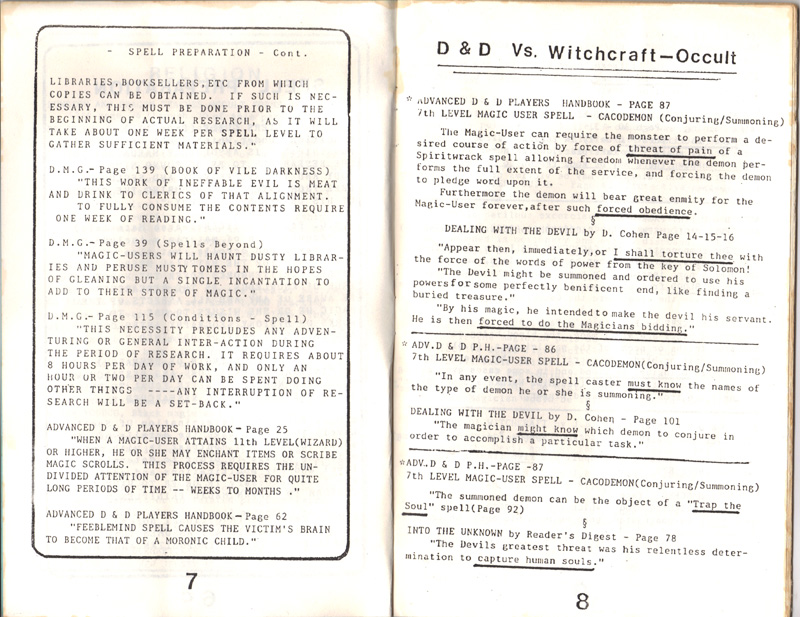
|

|
Main > Archives > As BADD As It Gets
(Click the left page to go back, or the right page to go forward) Page 7 (Text is
continued from previous page)
D.M.G. - Page 139 (Book of Vile Darkness) - This is a description of a powerful magic item that can be used as a plot point to the story. A character could find the book and attempt to use it, or become involved in a quest to destroy it. It does not describe a book that exists in reality. (Note that they fail to mention the Book of Exalted Deeds, on the previous page, which is the exact opposite - a holy book that benefits good aligned clerics.) The next three entries (DMG pgs 39 & 115, and the PHB pg 25) describe the same sort of activity described on the previous page - a player who wants their magic user character to research spells or create magic items must have their character removed from the game for periods of time while they "do their research." This is only to add a little realism to the game - and it isn't the player who is doing this research at all. (When you find a book in the library or anywhere else that shows you how to make a genuine Wand of Magic Missles, please let me know!) ADVANCED D&D PLAYERS HANDBOOK - Page 62 (Feeblemind Spell) This is just another spell description. No one really gets feebleminded when they play D&D. Page 8 "D&D
Vs.Witchcraft - Occult" - A
fight to the death!
Okay... maybe that's not what they meant. Here begins a section on comparisons between Dungeons & Dragons rules and text from books about the occult, satanism, and witchcraft. The purpose here is to show how similar the two are to each other, and to cause grave concern at these similarities. The comparisons are very tenuous, however. In the first case, the text of the Cacodemon spell (which allows an evil magic user to summon demons and have them do his/her bidding) is compared to two passages from Dealing with the Devil, by Daniel Cohen. The two red flags that appear here are the reference to a threat of pain or torture if the demon does not do the summoner's will, and that the demon is forced into obedience when it is summoned. The concept of summoning demons to do one's bidding is present in myths and legends around the world, and has become a part of many stories in fantasy literature, which were influential on the creation of Dungeons & Dragons. The Daniel Cohen book cited here is one of the many books the author wrote on the folklore of various subjects, including ghosts, UFOs, and creatures like Bigfoot. Quoting his work only establishes that these similarities are elements of the folklore of demons - not that these are the time-honored traditions of real demon summoning. The second and third examples are more cases of common legend regarding dealing with demons - the knowledge of a demon's name, without which the summoning cannot take place, and the trapping of souls. There are no real procedures for summoning demons or trapping souls in the Dungeons & Dragons rulebooks, nor are there names of real demons to summon. These things only exist in the game as props and characters for a story..
|

